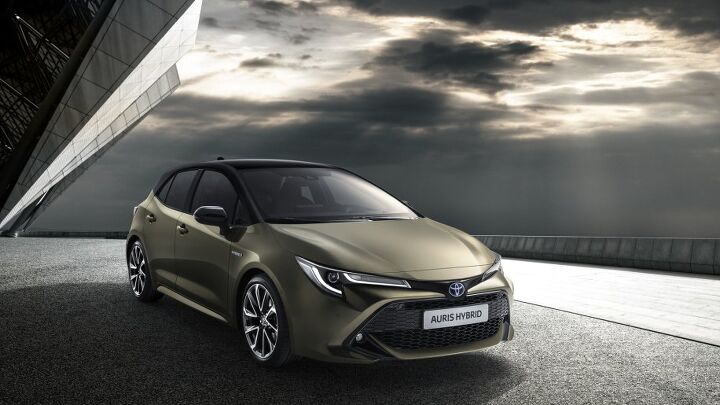New Toyota Auris Previews Next-generation Corolla IM Hatchback for North America

The Toyota Corolla iM is a bit of a paradox. The bodywork suggests it could be a fun-loving hot hatch, but the illusion dissipates the second you climb into the driver’s seat. The engine seems sick, unfit for the task it has been given, and the ergonomics leave something to be desired. While it’s not really much worse than the Corolla sedan, and it is a serviceable daily commuter for those wanting something affordably efficient, it doesn’t seem up to par with Toyota’s usual fare.
With Scion dead and buried in North America and the Corolla sedan outselling the iM ten-to-one, we’ve wondered if Toyota would even bother keeping the hatchback around. But it looks like it will. The automaker previewed the new Auris hatchback — a European model nearly identical to the Toyota (formerly Scion) iM — in Geneva this week, offering strong hints that it will make its way westward.
The overall concept has changed very little, but the new Auris transitions to the TNGA platform underpinning a good chunk of the brand’s fleet — including the current Corolla sedan in its next incarnation. It also appears to be more upscale, offering a two-tone roof and LED-infused illumination. However, we’re curious about the interior. The current iM feels rather cheap inside and has some of the worst ergonomics in recent memory. The armrest placement on the door is so comically bad, the driver’s side might as well not even have one.
While we aren’t sure if Toyota addressed this issue, it did fine-tune its engine lineup. As an economy car, it makes sense to offer it with a bevy of efficient engines. Toyota claims the next-generation Auris offers a conventional gasoline engine and at least two hybrid powertrains. The hybrids range from a 122-horsepower 1.8-liter unit to a 2.0-liter with 178 hp. However, the internal combustion unit is the same 1.2-liter turbo from the Euro-spec Yaris and CH-R.
That leaves us wondering what’s coming to North America. Toyota wasn’t willing to confirm whether or not the hybrids will make it here, but that 1.2-liter turbo doesn’t seem like an option. When it came time for the brand to bring the CH-R stateside, it opted to give it the old 2.0-liter and left the little turbo in Europe. Despite the larger engine’s extra helping of horsepower, the turbo unit’s early access to torque makes up for the disparity in overall power. So the question stands: what will the new Corolla hatch have under the hood when and if it gets here?
Whatever it is, we are willing to bet Toyota scraps the iM name to fully rope it in with the rest of the Corolla lineup. The hatchback will also come equipped with a new multilink rear suspension and wider footprint for improved handling. An inch shorter than the outgoing model, the new Auris hosts a wheelbase that’s lengthened by 1.6 inches. There’s also a lower roofline.
Odds are good the Corolla iM wouldn’t be updated until next year but, when that happens, it should be exceptionally similar to the new Auris. We’ve got our fingers crossed that the upmarket hybrid and its cheaper alternative will solve the current iM’s lethargy problem. If Toyota can also do something about the lackluster ergonomics, the hatch should be a solid little car, and perhaps worthy of the praise the current model lacks.
[Images: Toyota]

Consumer advocate tracking industry trends and regulations. Before joining TTAC, Matt spent a decade working for marketing and research firms based in NYC. Clients included several of the world’s largest automakers, global tire brands, and aftermarket part suppliers. Dissatisfied, he pivoted to writing about cars. Since then, he has become an ardent supporter of the right-to-repair movement, been interviewed about the automotive sector by national broadcasts, participated in a few amateur rallying events, and driven more rental cars than anyone ever should. Handy with a wrench, Matt grew up surrounded by Detroit auto workers and learned to drive by twelve. A contrarian, Matt claims to prefer understeer and motorcycles.
More by Matt Posky
Latest Car Reviews
Read moreLatest Product Reviews
Read moreRecent Comments
- Shoulderboards I like most of what the Jetta delivers. A couple of gripes. Lose the red stripe under the front end, the 1980 ‘s left 36 years ago.A proper 6-speed manual transmission should at least be an available feature if the DSG must be standard.
- Fred I like the digits for the speedometer, simple easy to read.
- Fred My TLX has a trunk with no hooks for a net so I got one of those trunk organizers. Just a cheap one from Amazon. Something to keep the groceries from sliding and spilling all over.
- Kjhkjlhkjhkljh kljhjkhjklhkjh its not even 2026 yet ... recall
- Mnemic Muscle cars are the only CARS still selling. Look up top 10 coupe sales from 5-6 years ago. Damn corvettes were outselling 2 door honda civics. Mustang, Challenger and Camaro were top 3 and by a huge margin, nothing else came close. With Charger being so huge there is room for Dodge to make a smaller coupe





































Comments
Join the conversation
Should I be disturbed by the front end of this car or do I have an overly active imagination?
I always thought the Lexus CT2ooh should have been sold as a Toyota Celica. Likewise, I think if they put the Celica name on the is new hatchback, they'd sell a lot more.